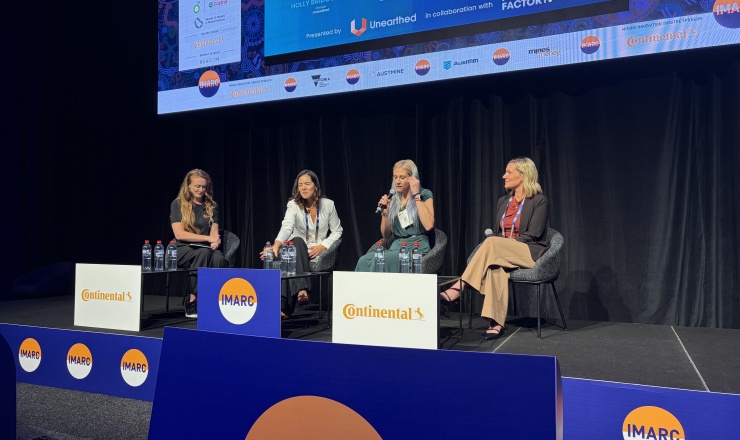
Funding the Future of Mining Tech at IMARC 2025
Hosted by Unearthed in collaboration with Founders Factory , our session “Funding the Future of Mining Tech” brought together a
Read articleOZ Minerals has extensive experience across the globe exploring for copper deposits. OZ Minerals are currently exploring in Peru, a highly prospective region for a range of economic minerals and metals. At present a great deal of Peru is under-explored and this presents a lot of opportunity to find new deposits.
A significant amount of country-scale satellite data has been collected and made publicly available. This data can be used to identify new regions in Peru that could host copper deposits. The Copa de Cobre Challenge was to use that data and apply machine learning to generate feature maps that highlight geological patterns, that can be used for exploration.
The challenge was ambitious because of the large volume of data, but also potentially game changing in reframing how we think about processing and using satellite data for geological interpretation, particularly in areas of low density of other data types.
Team GeoQuantic is a collaborative effort between Quentin Corlay and Paul Marchive. Quentin is a French geologist specialized in datascience. He is a PhD student in Heriot Watt (Edinburgh), and is working on applying machine learning solutions to seismic interpretation. His spends his spare time solving problems at the nexus between datascience and geoscience. Paul is a French geologist specialized in mineral exploration. He has been mainly exploring in the field in French Guiana’s Amazonian rainforest for gold deposits. He is now focusing on different metals in various metallogenic contexts globally.
The GeoQuantic approach successfully delineated discrete geological units across Peru, and was a neat machine learning application that could easily be scaled to other regions.
So why did Quentin and Paul take part in the challenge?
Satellite imagery exploration is a subject that triggered our interest and fitted both our specializations. The challenging part was to work on a huge amount of data (more than 400GB), hard to compute on a standard workstation. We liked the ambition of the project, extracting geologically meaningful information from satellite images and coming up with a solution that would be globally applicable.
The future of mining relies on the mining of data. Satellite imagery is truly a data gold mine for geological exploration. It is by unpuzzling the complexity of this data with machine learning approaches that we will unveil its true potential. We would like to thank OZ Minerals and Unearthed for giving us the opportunity of working on such a challenge.
ENERZAi is a newly formed data science startup in South Korea, delivering artificial intelligence solutions for the minerals and energy resources sector. Team ENERZAi recently received an honourable mention for the quality of their submission to the ExploreSA Challenge. Now they've stepped up to the podium applying their expertise in exploration and data science to Copa de Cobre.
We had already known that pre-processing was important (even more than modelling) even before the competition. But, coping with billions of pixels was hard but at the same time, rewarding.
In addition, talking to other members of community and the OZ Minerals team was invaluable experience for us. Listening to what others were saying helped us broaden our perspectives on data. We sincerely hope that we can keep talking on similar topics so that we can keep exploring!
Based in New York, Strayos specialize in developing advanced image processing and AI solutions designed to improve safety, efficiency, and productivity.
So much can be done with satellite data, and the Premio Niche prize was awarded to the team that came up with the most interesting and unique insight from the data, not necessarily related to the challenge. For our english speakers, premio niche translates to 'niche award'. Team ENERZAi were awarded this prize for their approach to map deforestation from the data.
One of the greatest things about open challenges is that many people can learn together, support each other, and take scientific areas of study forward in leaps! The Helping Hand prize was awarded to the person that contributed the most valuable insights, approaches or ideas that would help other people take on the challenge. Lucas is grad student at the University of São Paulo (USP), broadly interested in Geology, Remote Sensing and Machine Learning. His master’s thesis research topic is on the automatic detection of landslides scars with deep learning.
I'm fascinated about exploring geological data using data science techniques. As a Brazilian geologist, the Copa de Cobre competition was a great and exciting opportunity to sharpen my programming skills and broaden my understanding of South America's geology and Peru's specifically. Since the beginning of the competition, it was challenging to work with the data because the files were huge, and my computer could not handle it. Thus, I had to find some workarounds to open and analyze the data efficiently. It was incredible the learning process to find those solutions; therefore, I decided to share it with the other competitors to help them with those problems. It was great that the Copa de Cobre competition had a forum and the Helping Hand award because I truly believe that cooperative learning and problem solving is the best way to keep motivated and find the best solutions to a problem. I am pleased that my solution helped the other competitors.
The Exploracorn prize was awarded to the team that significantly contributed to advancing deep learning assisted mineral exploration. Team Zlataibakra (translating roughly to 'of copper and gold' in Serbian), comprise of Dina Klimentyeva, a Russian phD student at ETH in Zurich, studying applications of machine learning to exploration, and Boris Khvostichenko.
Zlataibakra produced a reusable workflow applying deep learning to the data set to generate prospectivity maps.